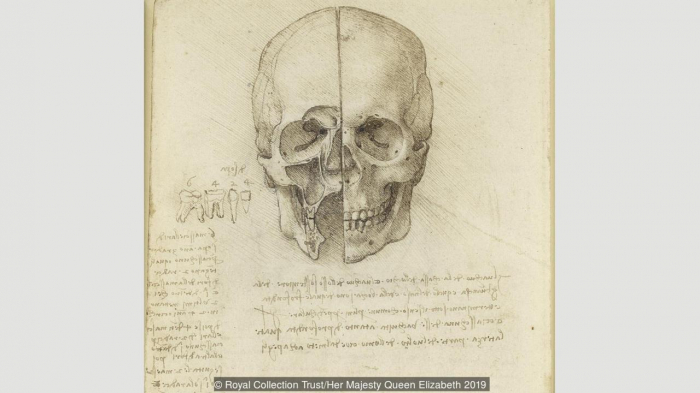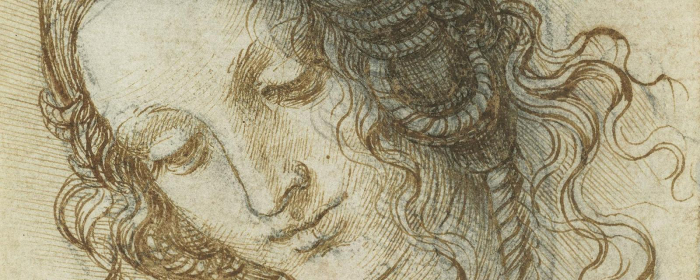Leonardo da Vinci is considered one of the most diversely talented individuals who ever lived and yet we have scant physical evidence of his genius. He created some of the greatest paintings of the Renaissance – but fewer than 20 survive with many, like The Last Supper or Salvator Mundi, so heavily restored that the hand of the master is scarcely visible. No sculptural or architectural project was ever completed and the many treatises he planned, including those on art and anatomy, remained unfinished.
That we are aware at all of Da Vinci’s astonishing versatility is thanks to his drawings. The delicately nuanced works in chalk, ink and colour wash, frequently accompanied by notes, reveal the full range of his interests including painting, sculpture, architecture, anatomy, engineering, cartography, geology and botany.

It’s possible that this drawing was an early study for Da Vinci’s painting A Lady with an Ermine (Cecilia Gallerani)
“Because they’re his private papers, that sense of looking over his shoulder at his mind at work is really quite thrilling,” says Martin Clayton, head of prints and drawings for The Royal Collection Trust, which is showing Da Vinci’s drawings at venues across the UK throughout 2019. And because they have survived in remarkable condition, they give a uniquely pure insight into his skill as an artist. “You can see every stroke that Leonardo made without any intervention in the succeeding 500 years,” says Clayton.

Drawings such as this, showing the drapery of the Madonna’s arm, c 1510-15, served as a guide for assistants working on the paintings
Although actual studies for his paintings form a relatively small part of the drawings, they are undoubtedly some of the most exquisite. Simple studies for the drapery featured in The Virgin and Child with Saint Anne are particularly beautiful. The swirl of fabric folds captures not just the form of the sleeve but also the effect of layered glazes in the painting which would act as a guide for the assistants working on it.
Sketches of masterpieces
They also allow us a glimpse of lost masterpieces. Da Vinci worked on two compositions for a painting of Leda and the Swan and a version with Leda standing was considered the most highly valued in the estate of his assistant and joint heir Salaì, but it appears to have fallen into disrepair when it entered the collections of the French court and was destroyed around 1700.

Da Vinci considered how Leda’s hair might look from behind, implying that he conceived her hair as a wig and that the drawings might have also been studies for real wigs
A study for the head of Leda shows a typically modest Da Vincian face with downcast eyes given unexpected vitality via an elaborate hairstyle of parallel plaits and dense whorls. We know from contemporary copies of the painting that it featured in the final version.
The anatomical studies may seem a world away from his art, but “the crucial thing to understand with Leonardo is how all his work is a unity”, says Clayton. “Very early on in his career he arrived at the idea that painting was essentially a scientific pursuit and should encompass scientifically verifiable, rational, objective effects… conversely all his scientific research has a very strong aesthetic component,” he says.

The skull sectioned, 1489: in another drawing of the brain, Da Vinci drew the cerebral ventricles as three cavities, housing imagination, reasoning and memory
Knowledge of anatomy was commonplace amongst artists of the time, but Da Vinci took it beyond mere observation of form, seeking the means to portray a living being with a soul. His investigations into the brain, including the highly innovative technique of injecting it with molten wax in order to determine its shape, were intended to further his understanding of human reasoning. Although this was of course ultimately futile, Clayton believes “his clear-sighted awareness that function and structure are not mutually comprehensible was a moment of real insight”.

In his studies of the heart and coronary vessels, c 1511-13, Da Vinci refuted the traditional belief that air passes from the lungs directly into the heart
According to Clayton, “the greatest of all Leonardo’s scientific pursuits” were his heart studies. Although a lack of ready human material forced him to use an ox, he came up with “some observations… how the valves for example function, that really aren’t found again until the 20th Century,” he says.
He always invests these drawings with a sense of awe – Martin Clayton
The finely detailed drawings of these investigations, although undoubtedly exquisite, are executed as dispassionately as possible in black and white, but his studies of embryology are somewhat different. The foetus in the womb is given a rare touch of colour as if to emphasise his appreciation of the miracle of life. “He always invests these drawings with a sense of awe,” says Clayton.

The foetus in the womb, c 1511: colour is usually absent in Da Vinci’s anatomical studies, but in this drawing he used red chalk, stepping back from a purely mechanical approach
Da Vinci’s fascination with reproduction and regeneration is key to understanding his most famous work, the Mona Lisa or La Gioconda. Although widely believed to be a portrayal of Lisa Giocondo, the wife of a wealthy Florentine, she transcends her identity to become “a portrait of woman as a reproductive agent in the context of the eternal universe”, explains Clayton.

Da Vinci drew trees at the edge of a wood with a range of touch, the chalk sharpened or used broadly, and occasionally wetted on the artist’s tongue to add density in the shadows
The symbolism is developed by the ancient landscape in the background, which signifies a timeless universality. Da Vinci’s studies of water and rock formations had led to a profound sense of the vast timescales involved in the Earth’s creation, with his observation of marine fossils in the mountains leading him to question the Biblical account of the flood. “He’s been called by people who are qualified to say this, the first geologist,” says Clayton.

In his studies of water, c1510-12, Da Vinci shows the eddies and bubbles resulting from water falling from a sluice into a pool, freezing the scene in time
Da Vinci’s studies of water were also prompted by his interest in civil engineering. The fact that he was employed by, amongst others, Cesare Borgia and Giuliano de Medici suggests he must have had sufficient understanding and reputation in the field to be considered one of its principal practitioners. He sketched plans for a canal to bypass an unnavigable section of the river Arno and although that never came to fruition it seems he was involved in projects to drain malarial marshes and construct locks.

Da Vinci’s map of Imola, 1502, was so accurate that it could still be used for directions today
While under employment by Borgia, he created what Clayton says is “probably the most accurate map of the Renaissance”, of the Italian city Imola. Having paced out the length of the streets, Da Vinci then took bearings from a central tower before presumably working out the layout by geometry on a lost sheet of paper. “You can lay Leonardo’s map on a modern map of Imola and it corresponds exactly,” says Clayton.

Gunpowder was introduced to European warfare during Da Vinci’s life, and his military drawings of the 1480s include designs for chariots and catapults as well as guns and mortars
His drawings of armaments, however, seem to have been a different matter. “There’s no evidence that any of these were ever built and it’s unlikely that any were intended to be built,” says Clayton. “It was more him wanting to make his mark in Milan, a city famous for its armaments, and get himself noticed at the Sforza court.”

During the 1480s, Ludovico Sforza – ruler of Milan – commissioned Da Vinci to create a bronze equestrian monument that would have been well over life size
While at that particular court, Da Vinci also worked on what would have been his greatest sculptural work, an equestrian monument to Ludovico Sforza’s father, Francesco. Numerous finely detailed sketches exist, and Da Vinci got as far as creating a model in clay – but when the forces of the French King Charles VII invaded Milan, it was used as target practice by his troops and destroyed. Early in his career, Da Vinci had written allegorical fables concerning man’s inherent capacity to destroy itself thorough greed and warfare, and experiences such as this can only have heightened his awareness of that fact.

In the last years of his life, Da Vinci was preoccupied with a cataclysmic storm overwhelming the Earth – and the futile struggles of humans against the forces of nature
Towards the end of his life he began to focus almost obsessively on drawings of apocalyptic deluges, in which there is nothing left but dust and water and debris. Clayton sees in these images an awareness of the ephemerality of human endeavour that derived from Da Vinci’s unique understanding of the great age of the Earth. He knew that anything man creates will ultimately crumble to dust, just as The Last Supper had begun to do in his own lifetime, while the forces of nature will prevail. The profound humility shown in these drawings is perhaps a greater testament to his genius than any of the lost or uncompleted works could ever have been.
BBC
More about: culture
















































